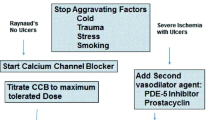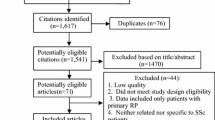Abstract
Raynaud’s phenomenon (RP) is a microvascular condition in which reversible ischemic attacks occur in the extremities. Due to the unpredictable nature of these attacks, pharmacologic agents that can be administered on as-needed basis are currently being sought after. Topical nitrates are well suited for as-needed use, and several different formulations have been studied for the treatment of RP, including ointments, gels, patches, and tapes. However, these different dosage forms are not all equal in terms of safety and efficacy, and not every one is commercially available for use in clinical practice. Nitroglycerin ointment is commercially available, and it has less systemic side effects than other topical formulations. Since its role in the treatment of RP has not yet been completely established, we performed a systematic search of Medline, Embase, and the Cochrane Central Register of Controlled Trials to evaluate its safety and efficacy. A total of 1125 studies were identified, and 7 were included in our review. Although the included studies used different measures of efficacy, the majority reported positive responses to nitroglycerin ointment. The benefit of nitroglycerin ointment in the treatment of RP may be further realized through more robust investigation.

Similar content being viewed by others
References
Belch J, Carlizza A, Carpentier PH et al (2017) ESVM guidelines—the diagnosis and management of Raynaud’s phenomenon. VASA 46:413–423
Maverakis E, Patel F, Kronenberg DG et al (2014) International consensus criteria for the diagnosis of Raynaud’s phenomenon. J Autoimmun 48:60–65
Hughes M, Snapir A, Wilkinson J et al (2015) Prediction and impact of attacks of Raynaud’s phenomenon, as judged by patient perception. Rheumatology 54:1443–1447
Thompson AE, Shea B, Welch V et al (2001) Calcium channel blockers for Raynaud’s phenomenon in systemic sclerosis. Arthritis Rheum 44:1841–1847
Ennis H, Hughes M, Anderson ME et al (2016) Calcium channel blockers for primary Raynaud’s phenomenon. Cochrane Database Syst Rev 2:CD002069
Rirash F, Tingey PC, Harding SE et al (2017) Calcium channel blockers for primary and secondary Raynaud’s phenomenon. Cochrane Database Syst Rev 12:CD000467
Herrick AL (2008) Raynaud’s phenomenon (secondary). BMJ Clin Evid (Online) 09:1125
McMahan ZH, Wigley FM (2010) Raynaud’s phenomenon and digital ischemia: a practical approach to risk stratification, diagnosis and management. Int J Clin Rheumtol 5(3):355–370
Herrick AL (2016) Recent advances in the pathogenesis and management of Raynaud’s phenomenon and digital ulcers. Curr Opin Rheumatol 28:577–585
Roustit M, Blaise S, Allanore Y et al (2013) Phosphodiesterase-5 inhibitors for the treatment of secondary Raynaud’s phenomenon: systematic review and meta-analysis of randomised trials. Ann Rheum Dis 72:1696–1699
Schiopu E, Hsu VM, Impens AJ et al (2009) Randomized placebo-controlled crossover trial of tadalafil in Raynaud’s phenomenon secondary to systemic sclerosis. J Rheumatol 36:2264–2268
Caglayan E, Axmann S, Hellmich M et al (2012) Vardenafil for the treatment of Raynaud phenomenon: a randomized, double-blind, placebo-controlled crossover study. Arch Intern Med 172:1182–1184
Fries R, Shariat K, von Wilmowsky H et al (2005) Sildenafil in the treatment of Raynaud’s phenomenon resistant to vasodilatory therapy. Circulation 112:2980–2985
Shenoy PD, Kumar S, Jha LK et al (2010) Efficacy of tadalafil in secondary Raynaud’s phenomenon resistant to vasodilator therapy: a double-blind randomized cross-over trial. Rheumatology 49:2420–2428
Herrick AL, van den Hoogen F, Gabrielli A et al (2011) Modified-release sildenafil reduces Raynaud’s phenomenon attack frequency in limited cutaneous systemic sclerosis. Arthritis Rheum 63:775–782
Agarwal V, Ghosh P, Sharma A et al (2010) Efficacy of tadalafil in Raynaud’s phenomenon secondary to systemic sclerosis: a double blind randomized placebo-controlled parallel group multicentric study (abstract). Arthritis Rheum 62(suppl 10):2086
Nossaman VE, Nossaman BD, Kadowitz PJ (2010) Nitrates and nitrites in the treatment of ischemic cardiac disease. Cardiol Rev 18:190–197
Wigley FM, Flavahan NA (2016) Raynaud’s phenomenon. N Engl J Med 375:556–565
Kleckner MS, Allen EV, Wakim KG (1951) The effect of local application of glyceryl trinitrate (nitroglycerine) on Raynaud’s disease and Raynaud’s phenomenon: studies on blood flow and clinical manifestations. Circulation 3:681–689
Fischer M, Reinhold B, Falck H et al (1985) Topical nitroglycerin ointment in Raynaud’s phenomenon. Z Kardiol 74:298–302
Anderson ME, Moore TL, Hollis S et al (2002) Digital vascular response to topical glyceryl trinitrate, as measured by laser Doppler imaging, in primary Raynaud’s phenomenon and systemic sclerosis. Rheumatology 41:324–328
Hughes M, Moore T, Manning J et al (2017) Reduced perfusion in systemic sclerosis digital ulcers (both fingertip and extensor) can be increased by topical application of glyceryl trinitrate. Microvas Res 111:32–36
Coppock JS, Hardman JM, Bacon PA et al (1986) Objective relief of vasospasm by glyceryl trinitrate in secondary Raynaud’s phenomenon. Postgrad Med J 62:15–18
Kleckner MS, Allen EV, Wakim KG (1950) Use of glyceryl trinitrate (nitroglycerin) ointment in the treatment of Raynaud’s disease and Raynaud’s phenomenon. Proc Staff Meet Mayo Clin 25:657–659
Franks AG (1982) Topical glyceryl trinitrate as adjunctive treatment in Raynaud’s disease. Lancet 1:76–77
Teh LS, Manning J, Moore T et al (1995) Sustained-release transdermal glyceryl trinitrate patches as a treatment for primary and secondary Raynaud’s phenomenon. Br J Rheumatol 34:636–641
Nahir AM, Schapira D, Scharf Y (1986) Double-blind randomized trial of Nitroderm TTS in the treatment of Raynaud’s phenomenon. Isr J Med Sci 22:139–142
Chung L, Shapiro L, Fiorentino D et al (2009) MQX-503, a novel formulation of nitroglycerin, improves the severity of Raynaud’s phenomenon: a randomized controlled trial. Arthritis Rheum 60:870–877
Hummers LK, Dugowson CE, Dechow FJ et al (2013) A multi-centre, blinded, randomised, placebo-controlled, laboratory-based study of MQX-503, a novel topical gel formulation of nitroglycerin, in patients with Raynaud phenomenon. Ann Rheum Dis 72:1962–1967
Tucker AT, Pearson RM, Cooke ED et al (1999) Effect of nitric-oxide generating system on microcirculatory blood flow in skin of patients with severe Raynaud’s syndrome: a randomised trial. Lancet 354:1670–1675
Curtiss P, Schwager Z, Cobos G et al (2018) A systematic review and meta-analysis of the effects of topical nitrates in the treatment of primary and secondary Raynaud’s phenomenon. J Am Acad Dermatol 78:1110–1118
Todd B (1986) Transdermal nitroglycerin ointment and patches. Geriatr Nurs 7:152–154
Nitroglycerin [monograph]. In: Lexicomp Online [online database]. Hudson, OH: Lexi-Comp. Accessed 22 Apr 18
Moinzadeh P, Riemekasten G, Siegert E et al (2016) Vasoactive therapy in systemic sclerosis: real-life therapeutic practice in more than 3000 patients. J Rheumatol 43:66–74
Foguera (2009) Nitro-bid (nitroglycerin ointment) [package insert]. Foguera, Melville
Bose N, Bena J, Chatterjee S (2015) Evaluation of the effect of ambrisentan on digital microvascular flow in patients with systemic sclerosis using laser Doppler perfusion imaging: a 12-week randomized double-blind placebo controlled trial. Arthritis Res Ther 17:44
Rosato E, Molinaro I, Borghese F et al (2010) Bosentan improves skin perfusion of hands in patients with systemic sclerosis with pulmonary arterial hypertension. J Rheumatol 37:2531–2539
Merkel PA, Herlyn K, Martin RW et al (2002) Measuring disease activity and functional status in patients with scleroderma and Raynaud’s phenomenon. Arthritis Rheum 46:2410–2420
Funding
No funding was obtained for this project.
Author information
Authors and Affiliations
Contributions
OQ, TC, ML, JEC and ERHD were involved in the topic generation. OQ, TC, and ML conducted the initial literature review. JEC and ERHD were involved with the initial manuscript review. All authors participated in the preparation of the final manuscript, read and approved the final version to be submitted. No external editing support was received.
Corresponding author
Ethics declarations
Conflict of interest
The authors, Ms. Qiu, Dr. Chan, Dr. Luen, Dr. Cruz, and Dr. Hermes-DeSantis, declare that they have no conflicts of interest.
Ethical approval
This article does not contain any studies with human participants or animals performed by any of the authors.
Electronic supplementary material
Below is the link to the electronic supplementary material.
Rights and permissions
About this article
Cite this article
Qiu, O., Chan, T., Luen, M. et al. Use of nitroglycerin ointment to treat primary and secondary Raynaud’s phenomenon: a systematic literature review. Rheumatol Int 38, 2209–2216 (2018). https://doi.org/10.1007/s00296-018-4119-9
Received:
Accepted:
Published:
Issue Date:
DOI: https://doi.org/10.1007/s00296-018-4119-9




